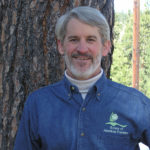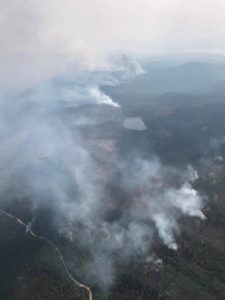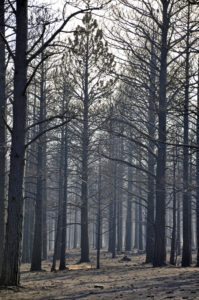
As I write this, the air above my home in Missoula, Montana, is filled with smoke.
At least 11 major wildfires are burning within 70 miles of town, and we haven’t had any measurable rain in over a month. There’s no moisture in the forecast for the next two weeks.
With these kinds of summers becoming the norm, it’s undoubtedly time to figure out how we can learn to live with fire.
It’s a conversation about risk management – something we do every day of our lives, often without thinking about it in those terms.
During fire season, whenever it occurs in your part of the country or world, the fires get top billing in the headlines on TV, radio and social media. But what do we do after the dramatic photographs go away?
If you’re like most people, particularly if you weren’t evacuated or lost property, even an active fire season quickly fades from the memory. You and your neighbors make no changes, preferring to remember the fires as something that happened “over there.” It’s over now, you rationalize.
And the reality is, the odds of a wildfire happening in your neighborhood are small. That’s why we hear the same lament each summer: “We didn’t think it would happen to us.”
But there are many things that can be done individually and collectively as a community, state and nation. We should talk about those strategies now while the fires are burning and immediately after the fires are out, while it is still fresh in our minds and we are spending millions of dollars repairing the damage.

Democracy is hard and unavoidably messy; it requires us to find common ground before we take action. And, of course, we often don’t agree on what needs to be done, who should pay for it and how it will be enforced. As Winston Churchill said, “Democracy is the worst form of government … except for all the others.”
But let’s think about the risk management we do individually and collectively to manage the risks posed by transportation. Individually, we teach our children to stop, look and listen before they cross the street. We require new drivers to take courses on the rules of the road and how to operate a vehicle; they must pass a test before earning a license. We hire police to enforce the rules, even though we all hate getting a ticket. We require car manufacturers to install seat belts and air bags, and engineers have designed cars so they collapse in a way that passengers are less likely to get hurt. We even require drivers to have insurance to at least cover damages to the other person and their property.
Why do we restrict ourselves in such a way? Because we recognize the potential benefits to ourselves and to our friends, neighbors and fellow citizens. These benefits have translated into fewer deaths (more than 50,000 per year in the late 1960s and ‘70s, down to less than 35,000 per year now), fewer injuries, and less sorrow for families and friends of the victims.
It also translates to an amazing amount of financial savings, which means lower insurance premiums, fewer lawsuits and fewer bankruptcies. Most of us put on our seat belt and follow the traffic laws every time we drive, even though the likelihood of being in an accident on that trip is minuscule. We accept the limitations on our personal freedom to reduce the risk to ourselves and to everyone around us.
So what can we do to reduce the risks associated with wildfire? We have collective experience and knowledge, research and many examples of success and even more of failures. This past month, through original stories in Treesource and several written by other publications, we have seen that Native Americans routinely used fire and lived with fire as a part of their landscape. We have seen that wilderness fires, over time, can become self-limiting for 6 to 16 years. Photographs of the same area through the years show that historical landscapes were much more open because of fire; we have learned, through assessments of areas treated to reduce the fuels, that fire behavior and negative effects of a wildfire are substantially reduced. We continue to see headlines about homes and other structures burning up and firefighters killed. We see fire suppression budgets and insurance rates going up.
So what can we do with the lessons we have learned? At Treesource, our lens for examining this question is through the three legs of sustainability. The solutions (no silver bullet here) must work environmentally, economically and socially – and there will be trade-offs between them.
This is where the democracy gets messy because we have some vocal folks who say, “We should just let the fires burn; it is natural.” And we have people who argue that we should extinguish every single fire. Some want more planned burning, some more thinning of the forest, and some want to stop all home construction outside of town. Some don’t want any smoke from the planned burns.

The reality is, we must engage in a discussion of the greater good. What is sustainable? What collective action is needed? What individual action is needed? How do we help our elected officials come to a consensus on the balance of individual rights and costs versus collective rights and costs? These are at the heart of the American democratic experiment for the past 240 years. Citizens must engage their elected officials, whether at the city, county, state or federal levels, to offer informed thoughts and rationale.
The really exciting thing is that we have many examples at the local level where a crisis has motivated a community to come together. We reported on the work in Flagstaff, Arizona, where a bond issue with 75-percent approval after a disastrous flood induced by a wildfire. We shared stories from the city of Denver, Colorado, and the town of John Day, Oregon, where officials are using mechanical harvesting and planned burning to manage their risks.
Each of these communities, large and small, reacted after they experienced a disastrous wildfire. Do we always need a disaster to provoke action, or can we learn from these increasingly plentiful examples?
We have been here before. Congress called for the development of a National Cohesive Wildland Fire Management Strategy, which has been produced by people from all levels of government, so we don’t have to start from scratch. But we do have to muster the collective will to make it happen.
The bottom line is, we know that reducing the fuel that feeds a wildfire reduces the intensity of subsequent fires and the severity of damage; it makes it easier, safer and more cost effective to fight the fire. And when we talk about the fuel, that means trees in the forest, what houses are made of, and how lots are landscaped. Treatments around homes, communities, municipal watersheds, communication sites, wildlife habitat and power lines are all ways of managing risk and learning to live with fire.
So while the smoke lingers in the air and flames command the television or computer screens, call or write your elected officials at all levels and say it is time we get to work on implementing solutions to this problem.
Bad outcome wildfires are only going to get bigger and more common if we do nothing. The choice is ours: more “good fire” or more “bad fire”? No fire is NOT an option.
Start the conversation.

Dave,
Good comments. Good work. Hope your summer is going well.
Cheers, Kevin
This Publisher’s Notebook essay of August 7 (Good Fire / Bad Fire) represents top-notch thinking, reporting and writing. Congratulations and high compliments to David Atkins!
His writing is conversational in style, which makes it accessible to a broad spectrum of readers.